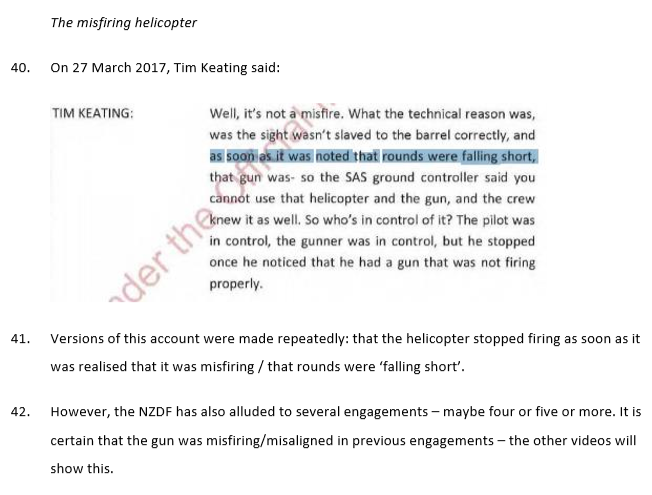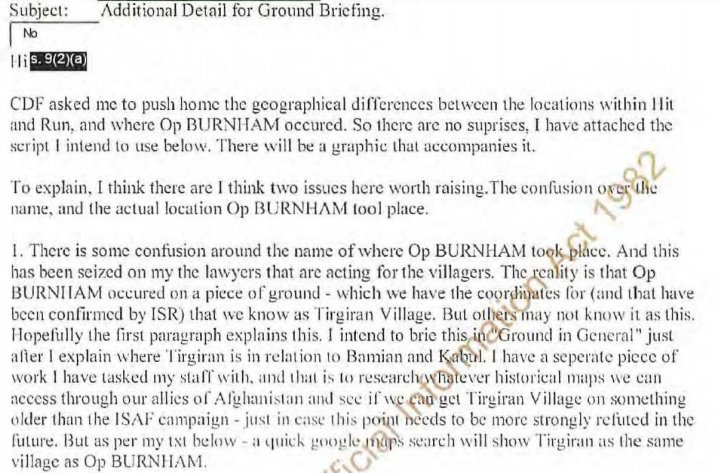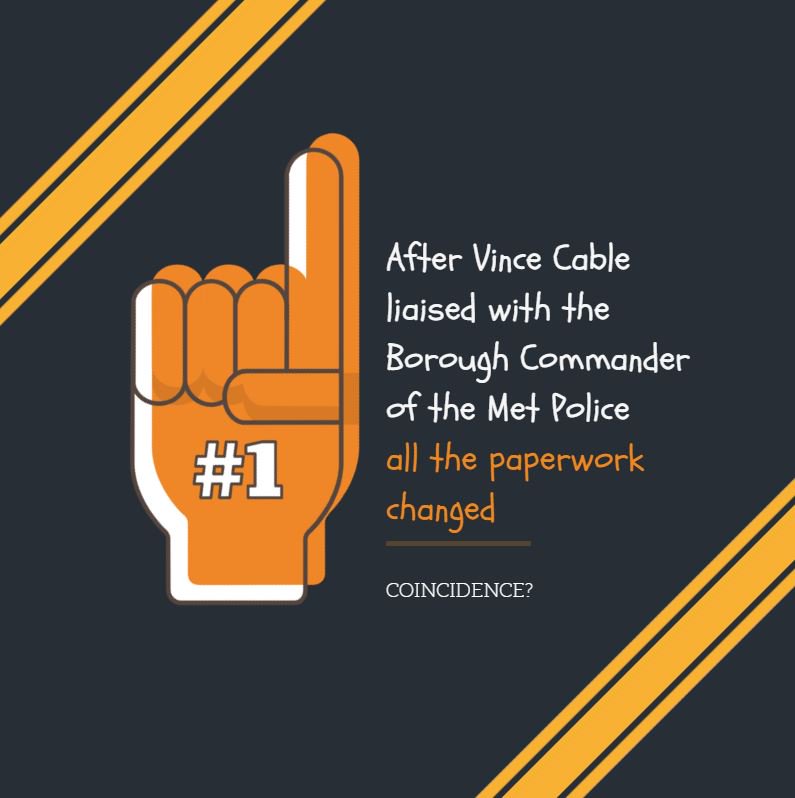- counsel for NZDF referring not to the Operation, but to internal handling of material and the transparency of its public statements
Whether that's true or not, the obvious question to Tim Eating later this week, is why he didn't feel the same.
"in hindsight" got five outings. Every one were things that seem to be obvious at the time
Response to a question about whether Rhys Jones should have picked things up as Mateparae's term ended less than a year after Operation Burnham.
Work. Plan.
Coleman was grumpy.
Coleman talked of eroding trust in NZDF because of this.
If you were wondering whether Operation Burnham was covered up, as Hit & Run claims, it seems that Coleman was too (just years and years before the book was published).
It was redacted in some participants' material, and available in others.
There was discussion about whether it should be released...
The NZDF said it should be treated as 'free and frank opinion', and tried to keep it secret.
Eventually they agreed to release it.
Smith claimed he does not recall who told him that, but it may have been the Chief of Defence Force (I didn't note when this note was made, so don't know which Chief).
- an investigation saying otherwise
- informant reports
- a grumpy Minister who had seen the investigation
He was asked about an email (he received?) from another member of the NZDF who asked along the lines of:...
Very approximate quote; wish the transcript was available sooner than next Friday.
McKinstry wished to correct his submitted written account.
It read that Wayne Mapp was in operation command (JTAC), when he had seen Mapp return to his hotel as Mapp requested.
Somehow the false statement about Mapp had made it into his statement because "there had been a general understanding that Mapp had been there".
Witnesses appearing behind closed doors have the option of individual legal support being paid for by NZDF, and there are strict walls.
Where are those walls here?
The members declined that petition.
This has resulted in cross-examination on changes in accounts like the above.
McKinstry was asked by counsel for Stephenson and Hager about the misaligned helicopter gun. In the public video, it is shown missing by some 20m, and in the IAF report buildings housing women and children.
This was to the next witness, Brigadier Chris Parsons, not McKinstry.
"...but I will resist the urge [to put it in an email] due to the discoverable nature of emails"
"Brigadier, you're getting yourself in a bit of a tangle here"
That ol' Kiwi charm.
"an elaborate explanation"
Then said he was sure he didn't.
Then, under author cross-examination, that he couldn't recall.
That was his final answer.
"our concerns about the book's treatment of location went well beyond the name given to the village in which the operation took place...
This will be a surprise to the NZDF as a whole who had sorted the location issue days prior to the March 2017 press conference.
thespinoff.co.nz/politics/14-03…
Most witnesses have used terms like "lessons learned" and "in hindsight", perhaps running a line prepared by NZDF.
Counsel to the Inquire: "Any mistakes?"
Keating: "No"
Counsel: "Not even in hindsight?"
Keating: "No"
And how much additional attention this would have required.
The big theme was that he considered a 14 line email from someone who claims to have read a single paragraph of the IAT report to be more credible than...
Parsons: "Yes"
Parsons: "I'm not a naval guy"
Counsel not buying Parsons's shit joke: "Turning a blind eye"
He didn't elaborate on what issues he had with these views:
They were injured when a wall collapsed on them after they had detonated explosive to gain access to a house.
The reason?: He did not know about the soldier being injured by a collapsed wall.
Yet *somehow* it had made it into his submission.
It is contaminating, standardising and biasing witnesses' submissions. It is difficult to know which parts of witnesses statements are their honest views, and which aren't.
After a question by counsel: "I can see how it could look like grasping for the answer we wanted"
This information was recorded in a register.
But not descriptive enough to note it contained the long-sought-after IAT report.
Counsel's suggestion was that this was to hide the report by Thompson or whoever provided it to him.
It took NZDF staff 15 minutes to locate it.
Began and ended in the few tweets here.
Keating did not.
McDonald: "Do you think [a week's] good enough?"
Keating: "Yes"
"No, I think you're incorrect".
McDonald suggested the looming election in 2014 might have played a part in top NZDF officials burying the IAT report...
And shortly after said there was a "clear firewall" between the NZDF and politicians on such matters...
And that perhaps the NZDF should have been the ones to clarify the record.
Keating: "you're wrong"
McDonald: "Did you tell them about this issue?"
[My note: Is it bad to have a favourite moment of the week, because this was mine.]
Keating: "The fact the document is found in a safe is not of public interest"
...
"that the document exists is"
McDonald: "How did you report back to the Minister?"
Keating: "I don't recall"
Keating: "It could have been hand-delivered" as opposed to email (suggesting that's why it hasn't been possible to locate the source of entry)
McDonald: "If so, wouldn't it be to someone senior?" and thus immediately narrowing...
We would soon learn that the person providing the IAT report to the Office of the Chief of Defence was the Director of Special Operations who is understood to have been Jim Blackwell.
A letter to the Human Rights Foundation: "The NZDF does not hold a copy of the IAT report". They did.
May also be of relevance to journalists who asked for it. @nkean
Long backwards and forwards between McDonald and Keating on 'unfounded' being used to describe civilian casualties.
Appears that the word was used to have up to four different meanings over the years.
Keating repeatedly said Hit & Run claimed women and children were deliberately targeted by the NZDF.
The authors have said women and children were killed by the Apache copters by rounds 'falling short' (quote is NZDF).
McDonald said that if he was worried about that, why didn't his responses and NZDF's PRs say that rather than 'civilian casualties were unfounded'.
"The context isn't there"
McDonald: Why didn't you put it in?
McDonald: "It's word-for-word the same"
She read it out.
Keating said there was a 'convention' that NZDF would not put out a press release if the Minister had already covered something, but under cross-examination said only sometimes did NZDF do this and sometimes they did not.
Back to the Human Rights Foundation...
I note that this is inconsistent with Keating's and Bill English's views that there was 'nothing new' in Hit & Run.
McDonald first suggested Hit & Run, and then a minute later the video of helicopters shooting buildings (which the NZDF also held), intelligence reports, and ISAF press releases
Suggestion by McDonald that a map at the time of the Operation identified Naik as where the NZDF went.
Re-examination by NZDF counsel suggest this may have been another village nearby, as 'Naik' is a common word.
Not much light here.
Keating refused to offer a view as to whether they were the target buildings.
Incredible.
McDonald: You've come to a hearing to talk about location, and you haven't prepared?
I suspect that the Inquiry has moved well beyond this stuff and it can be determined on paper. This hearing was mostly about pinning down the conspirators, if any.
But I'm definitely no lawyer!
Keating: "You need to listen to my answers"
"An angry Minister is a clear and present danger"
Counsel suggested, as I have, that the misfiring wouldn't have suddenly happened in the village, but would have been apparent in the hills too and that this is what the videos show.
This statement seems at odds with earlier testimony by McKinstry and the bigger US report into casualties and audio editing.
Hard to disagree with with the second sentence.
Back to the safe and registers...
When the NZDF lawyer went looking more recently, Chris Hoey was the safe's owner.
And here comes the big deal...
The lawyer had to have the safe drilled open.
I hope to be able to attend the reconvened one.









